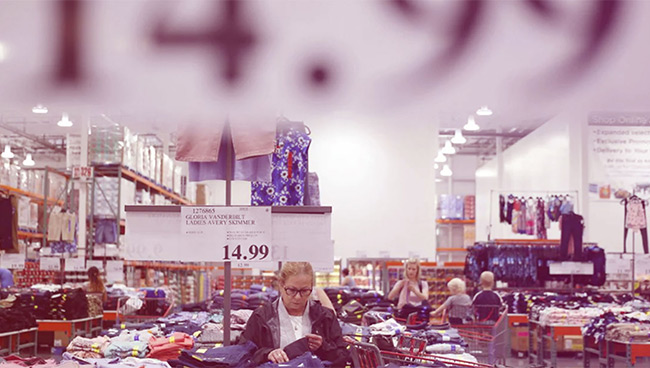By Abha Bhattarai // The Washington Post, July 1 2019
Kelly Davis has started doing something she once considered unthinkable: buying clothes at Costco.
The 31-year-old had long resisted the warehouse chain’s clothing aisle; it just felt weird buying dresses and shirts at the same place she bought groceries. Plus, she said, “It’s where my mom shops.”
But eventually, a pair of Jessica Simpson jeans — light blue, distressed, with holes — for only $13 did her in.
“Costco has really stepped up its game,” said Davis, who lives near Dallas. “The clothes are actually stylish. It’s not just old mom stuff anymore.”
At a time when retailers throughout the apparel industry are going to great lengths to reinvent their stores and websites to hold shoppers’ interest, Costco has emerged as an unlikely success story. Clothes and footwear now generate more than $7 billion a year in sales for Costco; that’s more than Old Navy, Neiman Marcus or Ralph Lauren. Revenue in that category has climbed about 9 percent a year since 2015, outpacing sales growth for food and electronics, according to recent earnings calls.
Those are stunning numbers for a retailer better known for its no-frills stores and bulk everything. Its nearly 800 locations don’t have fitting rooms, mannequins or window displays. Instead, tops and trousers are folded and piled high on tables, where shoppers can find Tommy Hilfiger, Eddie Bauer and Calvin Klein alongside Costco’s own Kirkland Signature line.
“Costco has quietly become an apparel destination,” said Simeon Siegel, a retail analyst for Instinet. “It is clearly resonating with shoppers and winning over brands at the expense of department stores.”
Dozens of major retailers, including Sears, David’s Bridal and Gymboree, have filed for bankruptcy in the past two years. Others, like Macy’s and J.C. Penney, are closing hundreds of stores as they try to figure out how to win back shoppers who have migrated online.
Costco, though, continues to do about 95 percent of its business in-store. Its 85 million members pay an annual fee, which starts at $60, to buy groceries, electronics, household items and clothing at near-wholesale prices.
“Costco does a good job of getting products customers want,” said Joe Feldman, a retail analyst for Telsey Advisory Group. “Lucky Brand jeans happen to be in the store this week, or North Face jackets. You see people coming back for the treasure hunt.”
Low prices don’t hurt, either. Costco is able to offer some of the best deals in the industry, analysts said, because it caps its profit margins at about 15 percent. North Face men’s jackets were recently selling for $69.97 on Costco.com (compared with $149.99 elsewhere on the Internet), while Adidas women’s slip-on sneakers were priced at $24.99 (versus $60 on Adidas.com).
The company also has massive bargaining power. Its $141 billion in annual revenue makes it the nation’s fourth-largest retailer, behind Walmart, Kroger and Amazon.
“I wouldn’t say Costco has an extensive range of fashion, but it is adding new colors and silhouettes,” said Wendy Liebmann, chief executive of the consultancy WSL Strategic Retail. “It has become a viable place for people to buy clothing.
Costco stores, analysts said, have become an attractive destination for brands to offload unsold merchandise without tarnishing their reputations. The chain’s shoppers tend to have household incomes of $100,000 or more, making them a coveted demographic for high-end brands. As a result, analysts say, Costco has been able to expand its lineup of upscale goods in recent years to include North Face hoodies, Birkenstock sandals and Ugg boots. Earlier this year, the company sold a $400,000 diamond ring that executives said helped boost quarterly same-store sales. (Representatives for Ugg and Birkenstock said they do not sell directly to Costco, which did not respond to multiple requests for comment.)
“If you’ve got a lot of inventory, dropping off a pallet at Costco and having it disappear by the end of the weekend isn’t the worst thing,” Siegel said. “It’s a way to move goods without hurting your brand.”
Customers, he said, like buying clothes at Costco for the same reasons they like shopping at off-price department stores like T.J. Maxx and Marshalls: the thrill of the hunt. Stores are constantly getting new products, and many name-brand items sell out in a day or two.
“If you see something you like, you have to grab it right away,” said Michele Kulwin, a fourth-grade teacher in Lake Barrington, Ill., who shops at Costco twice a week. “I starting buying pajamas at Costco, then underwear and now I’m like, ‘Oh my gosh, everything is so cute.’ ”
Kulwin’s favorite coat is from Costco, as are most of her work clothes. She likes the pared-down selection, she said, because it keeps her from feeling overwhelmed. (Shopping at T.J. Maxx, by comparison, is “way too stressful,” she said.)
That, analysts say, is another key to Costco’s success: It offers few choices. Today’s shoppers don’t want to rummage through racks of clothing or decide between dozens of styles of jeans. They want retailers to do the searching for them, and give them a handful of foolproof options.
“I always tell people, ‘Building a wardrobe at Costco is a marathon, not a track meet,’” said Stephanie Kretschmer, 39, whose Instagram account, @costcocasual, is devoted to her weekly clothing finds. “I’ve picked up a lot of basics — white jeans, olive pants, utility jackets, dresses — but you have to curate it over time.”
Davis, the shopper from Texas, now buys just about all of her clothes at Costco, including underwear, dresses and blouses. She posts pictures of her purchases on Instagram and picks up hoodies and sweatpants for friends who don’t have a membership.
Recently she arrived at a family gathering to find that she, her mother and her 80-year-grandmother were all wearing the same funnel-neck pullover from Costco.
“It was kind of ridiculous,” she said. “But there we were: three generations in head-to-toe Costco.”


